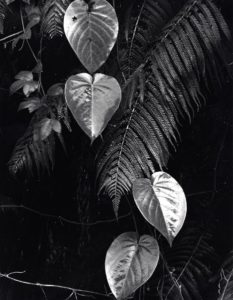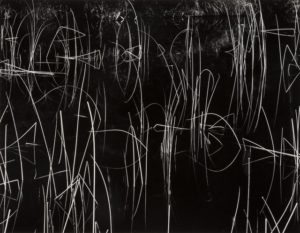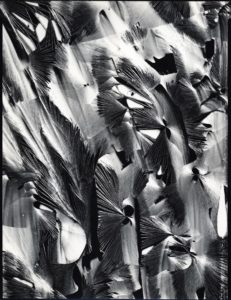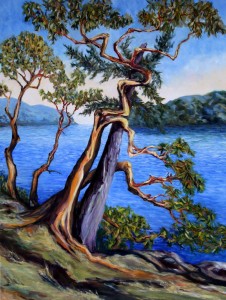Dear Artist,
A traditional art form has been greatly facilitated by the advent of the digital camera. The art of Miksang was begun as a meditational tool by Shambhala Buddhists, but it has implications for painters and other creative people. The idea is to find joy and awareness by attending to the minor and seemingly insignificant — the colours, patterns and textures that exist in the close-up world. Miksang is a Tibetan word that means “good eye.” Shambhalas think widespread use might lead to more compassionate and enlightened societies.
Artists have been going in this direction for centuries. Leonardo recommended seeing beauty and finding motifs in the texture of walls. You might remember several years ago I demonstrated the use of a special camera set-up, and encouraged the practice of close-up looking and capturing.
These days Buddhist instructors in several countries are handing digital cameras to kids. Children seem to take to it faster than adults and, according to some, get better results. Instructors need to be certified by the Toronto-based ” Miksang Society for Contemplative Photography.” Part of the Miksang philosophy is that subjects must be found and collected “as is” and not moved or adjusted to improve composition. Subjects can be man-made or from the natural world.
What value does Miksang have for creative folks? Obviously, Miksang makes for pause, reflection and quiet centering. By increasing awareness, one builds a feeling of wonder and kinship with the overlooked. But its real value is in seeing design and the subtlety of colour. To the discriminating eye the macro world is a minor symphony. Looking through a viewfinder and making decisions hone the ability to find the larger compositions. It’s all about the acquired skills of looking and seeing. Buddhist or not, this art can be performed at any time and any place.
Digital photography has been a bit of a shock for the formerly film-based who thought of cost every time they pressed the shutter. Digitals are essentially “free” until you do something with them. The act of capture becomes like a prayer — free for the asking. Miksang praises the world of small.
Best regards,
Robert
PS: “To see a world in a grain of sand
And a heaven in a wild flower,
Hold infinity in the palm of your hand
And eternity in an hour.” (William Blake)
Esoterica: A valuable exercise is to select a small area such as the corner of a garden, a children’s playground or even a traffic island. Any inconsequential area will do. Most digital cameras have an icon (usually a flower) that sets the camera for fast close-up focus. Take CU’s of everything you can find — from dew drops to bottle tops. Assess the design of each shot and frame accordingly. You can put hundreds into the camera in half an hour. Before you edit out your “failures,” load them into your computer and give yourself a slide show. Don’t be judgmental. Let it all dissolve by at one or two second intervals. You will be taken away, Zen-like, to a world of amazing detail, colour and design.
There are currently 30,459 miksang images on Flickr. That’s up from the 3,112 my Dad mentioned when this letter was originally published as Working with Miksang on June 12, 2007.
Have you considered a Premium Artist Listing? With each letter, an artist is featured at the bottom of this page. The Premium Artist Listings are a means of connecting artist subscribers through their work. Proceeds from each listing contribute to the production of The Painter’s Keys.
“There’s nothing worth photographing more than 100 yards from the car.” (Brett Weston)
Featured Workshop
 This retreat is an homage to early pioneers of plein air painting. We canoe-in and camp, paddling every day to our painting locations. This is a self-catered trip. We provide the canoes, life jackets and instruction. You bring your own provisions, tents, etc. The scenery in Kawartha Highlands is fantastic. Bald rock faces, sparkling lakes, majestic trees. Every direction you turn is another painting. Your instructor, Keith Thirgood, has been camping and canoeing all his life, and teaching artists his own unique approach to painting for over 12 years. Learn how to find order in the chaos, control your colours and create paintings that work. Learn modern colour theory, values, shapes and lines, what makes for a good painting.
This retreat is an homage to early pioneers of plein air painting. We canoe-in and camp, paddling every day to our painting locations. This is a self-catered trip. We provide the canoes, life jackets and instruction. You bring your own provisions, tents, etc. The scenery in Kawartha Highlands is fantastic. Bald rock faces, sparkling lakes, majestic trees. Every direction you turn is another painting. Your instructor, Keith Thirgood, has been camping and canoeing all his life, and teaching artists his own unique approach to painting for over 12 years. Learn how to find order in the chaos, control your colours and create paintings that work. Learn modern colour theory, values, shapes and lines, what makes for a good painting.Featured Artist
I am a landscape painter exposing the mystery in an ordinary day.








5 Comments
I so enjoyed this letter! Thank you for the details and reminder to stop and look CU. The assignment is also appreciated
I truly believe that whether it is the colours, patterns and textures that exist in the close-up world or from a more distant view that it is here that we can expose the mystery in an ordinary day. As Robert mentions “its real value is in seeing design and the subtlety of colour.” It is here in these observations that my whole body hums as my brush moves across a canvas or gessobord. I don’t think there is another aspect of living where I consistently feel so alive and alert. Just to sink into the still point of such a moment…. well, I shall leave it at that. All the best of today Sarah and all!
Miksang, as I was taught, has nothing to do with small, or up close. It is, rather, training yourself to see pure perceptions – without an overlay of concept. We trained by noticing what came into our eye as colour, texture, form – not going “ah – a gorgeous sunset” or “child playing with red ball”. We’d often do field trips in places of industrial wreckage. When I first started this contemplative practice, most of us were using film. We’d shoot slides and meet the next week to show what we’d done and get into lengthy debates on our images. It was wonderful training for seeing which benefits the making of all visual art – even abstract. For interested folks check out Michael Wood, Julie Boise, or Andy Carr. All good teachers.
Auto-corrected ! It is Andy Karr. And Julie DuBose (my flub) …
Thank you for mentioning Michael Wood and Julie DuBose. They have been my teachers numerous times. I continue to be in awe of their way of “seeing” and being and approaching the world. It is just the way for them. I am still in and out. It’s a daily practice…